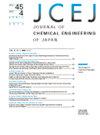高抗烧结性、高抑焦性生物乙醇高效蒸汽重整催化剂包覆Ni纳米颗粒的研制
IF 1.2
4区 工程技术
Q4 ENGINEERING, CHEMICAL
引用次数: 0
摘要
生物乙醇的蒸汽重整是一种潜在的制氢反应。开发具有抗烧结、抗结焦和热稳定性的活性镍催化剂是实际应用中不可缺少的。在本研究中,提出了Ni纳米颗粒在Silicalite-1内部的封装结构作为催化剂(Ni@Silicalite-1)。采用水热合成法,以叶状硅酸镍为Ni前驱体制备了该催化剂。在500-800°C的条件下进行了催化活性的研究,并研究了催化剂的性能,包括表面形貌、Ni性能和废催化剂上的焦炭形成情况,与传统的Ni/Silicalite-1进行了比较。Ni@Silicalite-1具有较高的乙醇转化率、产氢率和对C1产物的选择性。特别是在动力学控制条件下(500 - 600℃),Ni@Silicalite-1在500℃下乙醇转化率为46.8%,在600℃下co2到c1的转化率是Ni/Silicalite-1的两倍。此外,在不同的反应温度下,Ni@Silicalite-1的焦炭抑制效果是浸渍催化剂的2-5倍。在高温下(800°C 4 h) ESR后,其Ni尺寸保持在4.0-4.1 nm,具有良好的抗烧结性能。因此,硅石-1内部的超细Ni纳米颗粒封装结构在生物乙醇蒸汽重整中具有良好的应用前景。本文章由计算机程序翻译,如有差异,请以英文原文为准。
Development of Ni Nanoparticle Encapsulated with Silicalite-1 Catalyst for High Activity Steam Reforming of Bioethanol with High Sintering Resistance and Coke Suppression
Steam reforming of bioethanol is a potential reaction for H2 production. The development of active Ni catalysts with sintering resistance, coking resistance and thermal stability is indispensable for practical application. In this study, the encapsulation structure of Ni nanoparticles inside Silicalite-1 was proposed as a catalyst (Ni@Silicalite-1). The catalyst was prepared by hydrothermal synthesis using Ni-phyllosilicate as a Ni precursor. An investigation of catalytic activity was conducted at 500–800 °C, along with an investigation of catalyst properties, including surface morphology, Ni properties, and coke formation on the spent catalysts, compared to a conventional Ni/Silicalite-1. Ni@Silicalite-1 exhibits a higher ethanol conversion, hydrogen production, and selectivity towards C1 products. Especially in a kinetic control condition (500–600 °C), Ni@Silicalite-1 exhibits 46.8% in ethanol conversion at 500 °C and two times higher in C2-to-C1 conversion at 600 °C than that of Ni/Silicalite-1. Moreover, a significant coke suppression of 2–5 times reduction form that of impregnation catalyst is obtained for Ni@Silicalite-1 in various reaction temperatures. It also shows a sintering resistance as maintaining the Ni size at 4.0–4.1 nm after ESR at high temperature (800 °C 4 h). Therefore, the encapsulation structure of ultrafine Ni nanoparticles inside Silicalite-1 is promising for bioethanol steam reforming.
求助全文
通过发布文献求助,成功后即可免费获取论文全文。
去求助
来源期刊

Journal of Chemical Engineering of Japan
工程技术-工程:化工
CiteScore
1.70
自引率
12.50%
发文量
51
审稿时长
1.9 months
期刊介绍:
The Journal of Chemical Engineering of Japan (JCEJ) is a monthly publication in English of the Society of Chemical Engineers, Japan. The first issue appeared in 1968. JCEJ publishes timely original research in the broad field of chemical engineering ranging from fundamental principles to practical applications. JCEJ is an international research journal and invites your contributions and subscriptions.
All areas of chemical engineering are covered, including:
Physical Properties and Physical Chemistry,
Transport Phenomena and Fluid Engineering,
Particle Engineering,
Separation Engineering,
Thermal Engineering,
Chemical Reaction Engineering,
Process Systems Engineering and Safety,
Biochemical,
Food and Medical Engineering,
Micro and Nano Systems,
Materials Engineering and Interfacial Phenomena,
Energy, Environment, and
Engineering Education.
 求助内容:
求助内容: 应助结果提醒方式:
应助结果提醒方式:


